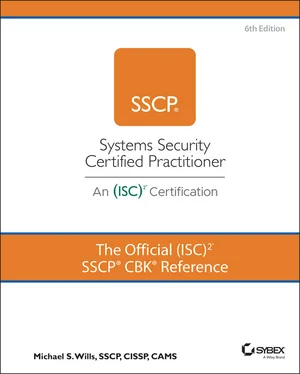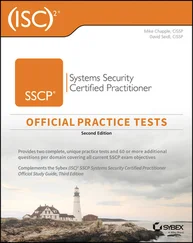Mike Wills - The Official (ISC)2 SSCP CBK Reference
Здесь есть возможность читать онлайн «Mike Wills - The Official (ISC)2 SSCP CBK Reference» — ознакомительный отрывок электронной книги совершенно бесплатно, а после прочтения отрывка купить полную версию. В некоторых случаях можно слушать аудио, скачать через торрент в формате fb2 и присутствует краткое содержание. Жанр: unrecognised, на английском языке. Описание произведения, (предисловие) а так же отзывы посетителей доступны на портале библиотеки ЛибКат.
- Название:The Official (ISC)2 SSCP CBK Reference
- Автор:
- Жанр:
- Год:неизвестен
- ISBN:нет данных
- Рейтинг книги:4 / 5. Голосов: 1
-
Избранное:Добавить в избранное
- Отзывы:
-
Ваша оценка:
- 80
- 1
- 2
- 3
- 4
- 5
The Official (ISC)2 SSCP CBK Reference: краткое содержание, описание и аннотация
Предлагаем к чтению аннотацию, описание, краткое содержание или предисловие (зависит от того, что написал сам автор книги «The Official (ISC)2 SSCP CBK Reference»). Если вы не нашли необходимую информацию о книге — напишите в комментариях, мы постараемся отыскать её.
The Official (ISC)2 SSCP CBK Reference
SSCP Study Guide
The Official (ISC)2 SSCP CBK Reference
The Official (ISC)2 SSCP CBK Reference — читать онлайн ознакомительный отрывок
Ниже представлен текст книги, разбитый по страницам. Система сохранения места последней прочитанной страницы, позволяет с удобством читать онлайн бесплатно книгу «The Official (ISC)2 SSCP CBK Reference», без необходимости каждый раз заново искать на чём Вы остановились. Поставьте закладку, и сможете в любой момент перейти на страницу, на которой закончили чтение.
Интервал:
Закладка:
Public places are areas or spaces in which anyone and everyone can see, hear, or notice the presence of other people and observe what they are doing, intentionally or unintentionally. There is little to no degree of control as to who can be in a public place. A city park is a public place.
Private places are areas or spaces in which, by contrast, you as owner (or person responsible for that space) have every reason to believe that you can control who can enter, participate in activities with you (or just be a bystander), observe what you are doing, or hear what you are saying. You choose to share what you do in a private space with the people you choose to allow into that space with you. In law, this is your reasonable expectation of privacy, because it is “your” space; and the people you allow to share that space with you share in that reasonable expectation of privacy.
Your home or residence is perhaps the prime example of what we assume is a private place. Typically, business locations can be considered private in that the owners or managing directors of the business set policies as to whom they will allow into their place of business. Customers might be allowed into the sales floor of a retail establishment but not into the warehouse or service areas, for example. In a business location, however, it is the business owner (or its managing directors) who have the most compelling reasonable expectation of privacy, in law and in practice. Employees, clients, or visitors cannot expect that what they say or do in that business location (or on its IT systems) is private to them and not “in plain sight” to the business. As an employee, you can reasonably expect that your pockets or lunch bag are private to you, but the emails you write or the phone calls you make while on company premises are not necessarily private to you. This is not clear-cut in law or practice, however; courts and legislatures are still working to clarify this.
The pervasive use of the Internet and the web and the convergence of personal information technologies, communications and entertainment, and computing have blurred these lines. Your smart watch or personal fitness tracker uplinks your location and exercise information to a website, and you've set the parameters of that tracker and your web account to share with other users, even ones you don't know personally. Are you doing your workouts today in a public or private place? Is the data your smart watch collects and uploads public or private data?
“Facebook-friendly” is a phrase we increasingly see in corporate policies and codes of conduct these days. The surfing of one's social media posts, and even one's browsing histories, has become a standard and important element of prescreening procedures for job placement, admission to schools or training programs, or acceptance into government or military service. Such private postings on the public web are also becoming routine elements in employment termination actions. The boundary between “public” and “private” keeps moving, and it moves because of the ways we think about the information, not because of the information technologies themselves.
GDPR and other data protection regulations require business leaders, directors, and owners to make clear to customers and employees what data they collect and what they do with it, which in turn implements the separation of that data into public and private data. As an SSCP, you'll probably not make specific determinations as to whether certain kinds of data are public or private; but you should be familiar with your organization's privacy policies and its procedures for carrying out its data protection responsibilities. Many of the information security measures you will help implement, operate, and maintain are vital to keeping the dividing line between public and private data clear and bright.
Privacy versus Security, or Privacy and Security
It is interesting to see how the Global War on Terror has transformed attitudes about privacy throughout the Western world. Prior to the 1990s, most Westerners felt quite strongly about their individual rights to privacy; they looked at government surveillance as intrusive and relied upon legal protections to keep it in check. “That's none of your business” was often the response when a nosy neighbor or an overly zealous official tried to probe too far into what citizens considered as private matters. This agenda changed in 2001 and 2002, as national security communities in the United States and its NATO allies complained bitterly that legal constraints on intelligence gathering, information sharing, and search and seizure hampered their efforts to detect and prevent acts of terrorism. “What have you got to hide,” instead, became the common response by citizens when other citizens sought to protect the idea of privacy.
It is important to realize several key facets of this new legal regime for the 21st century. Fundamentally, it uses the idea that international organized crime, including the threat of terrorism, is the fundamental threat to the citizens of law-abiding nations. These new legal systems require significant information sharing between nations, their national police and law enforcement agencies, and international agencies such as the OECD and Interpol, while also strengthening the ability of these agencies to shield or keep secret their demands for information. This sea change in international governance started with the Uniting and Strengthening America by Providing Appropriate Tools Required to Intercept and Obstruct Terrorism Act of 2001, known as the USA PATRIOT Act. This law created the use of National Security Letters (NSLs) as classified, covert ways to demand information from private businesses. The use of NSLs is overseen by the highly secret Foreign Intelligence Surveillance Court, which had its powers and authorities strengthened by this Act as well. Note that if your boss or a company officer is served with an NSL demanding certain information, they cannot disclose or divulge to anyone the fact that they have been served with such a due process demand. International laws regarding disclosure and reporting of financial information, such as bank transactions, invoices and receipts for goods, and property purchases, are also coming under increasing scrutiny by governments.
It's not the purpose of this chapter to frame that debate or argue one way or another about it. It is, however, important that you as an information security specialist within your organization recognize that this debate is not resolved and that many people have strongly held views about it. Those views often clash with legal and regulatory requirements and constraints regarding monitoring of employee actions in the workplace, the use of company information or information systems by employees (or others), and the need to be responsive to digital discovery requests of any and every kind. Those views and those feelings may translate into actions taken by some end users and managers who are detrimental to the organization, harmful to others, illegal, unethical, or all of these to a degree. Such actions—or the failure to take or effectively perform actions that are required—can also compromise the overall information security posture of the organization and are an inherent risk to information security, as well as to the reputation of the organization internally and externally.
Your best defense—and your best strategy for defending your company or your organization—is to do as much as you can to ensure the full measure of CIANA+PS protections, including accountability, for all information and information systems within your areas of responsibilities.
Nonrepudiation
The fundamental design of the earliest internetworking protocols meant that, in many cases, the sender had no concrete proof that the recipient actually received what was sent. Contrast this with postal systems worldwide, which have long used the concept of registered mail to verify to the sender that the recipient or his agent signed for and received the piece of mail on a given date and time. Legal systems have relied for centuries on formally specified ways to serve process upon someone. Both of these mechanisms protect the sender's or originator's rights and the recipient's rights: Both parties have a vested interest in not being surprised by claims by the other that something wasn't sent, wasn't done, or wasn't received. This is the basis of the concept of nonrepudiation , which is the aspect of a system that prevents a party or user from denying that they took an action, sent a message, or received a message. Nonrepudiation does not say that the recipient understood what you sent or that they agreed with it, only that they received it.
Читать дальшеИнтервал:
Закладка:
Похожие книги на «The Official (ISC)2 SSCP CBK Reference»
Представляем Вашему вниманию похожие книги на «The Official (ISC)2 SSCP CBK Reference» списком для выбора. Мы отобрали схожую по названию и смыслу литературу в надежде предоставить читателям больше вариантов отыскать новые, интересные, ещё непрочитанные произведения.
Обсуждение, отзывы о книге «The Official (ISC)2 SSCP CBK Reference» и просто собственные мнения читателей. Оставьте ваши комментарии, напишите, что Вы думаете о произведении, его смысле или главных героях. Укажите что конкретно понравилось, а что нет, и почему Вы так считаете.












